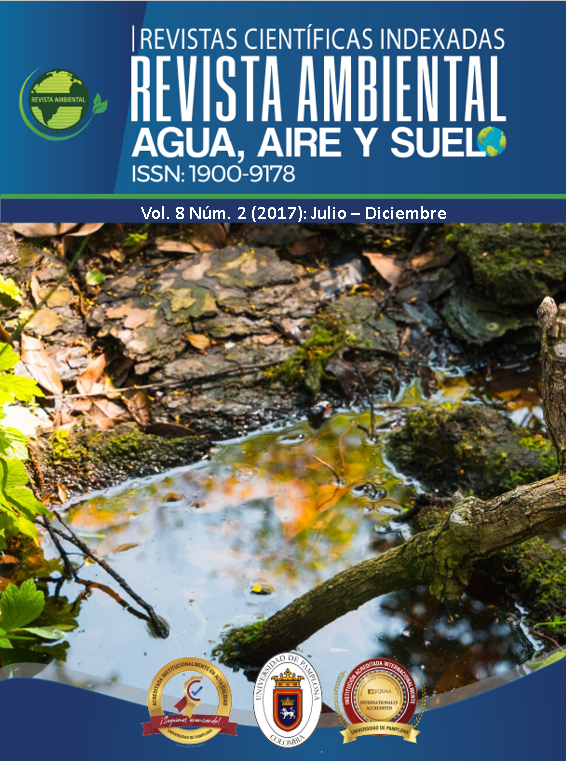Evaluation of the Adsorption of Cu+2 and Methylene Blue on Low-Cost Biosorbents Obtained from Residual Biomass of the Citrus Agroindustry
DOI:
https://doi.org/10.24054/aaas.v8i2.2063Keywords:
Absorbentes, azul de metileno, carboxilos, FTIRAbstract
In response to the needs in agro-industrial research for the utilization of agro-industrial residues, this work focused on developing adsorbent materials from lemon, orange, and tangerine peels with activity to remove methylene blue dye, and, in effect, to demonstrate their potential for use in the elimination of organic water contaminants. The adsorbents were prepared by drying, grinding, and macerating the citrus residues, followed by activation with citric acid and calcination in a nitrogen atmosphere. They were characterized through acid-base titration to determine the concentration of acidic and basic sites, FTIR infrared spectroscopy, and were evaluated through absorption tests using the organic dye methylene blue.
It was determined that the use of materials obtained from citrus agro-industrial residues, such as lemon, orange, and tangerine peels, for the removal of contaminant molecules is viable, as they exhibit the ability to adsorb methylene blue in batch experiments. Among them, tangerine residues showed the highest performance, followed by lemon, and then orange. This capacity is attributed to the abundant presence of oxygenated groups (-C-O), such as alcohols and carboxylic acids, on the surface of the adsorbent material.
Equilibrium and kinetic studies were conducted for the adsorption of Cu2+ using activated tangerine (Mandarina(act)) and C_Mandarina. The isotherm data were analyzed using Langmuir, Freundlich, Temkin, and Dubinin-Radushkevich models. Characteristic parameters and correlation coefficients were determined for each isotherm. The Langmuir isotherm provided the best correlation for Cu2+ adsorption for both Mandarina(act) and C_Mandarina. Adsorption kinetics were studied using pseudo-first-order and pseudo-second-order equations, the Elovich equation, and the intraparticle diffusion equation. The pseudo-second-order equation provided the best correlation coefficient between the calculated values and the experimental data.
Downloads
References
Amerkhanova, S., & Shlyapov, R. (2017). The active carbons modified by industrial wastes in process of sorption concentration of toxic organic compounds and heavy metals ions. Colloids and Surfaces A: Physicochemical and Engineering Aspects, 532, 36-40.
Acero, J., et al. (2012). Coupling of adsorption, coagulation, and ultrafiltration processes for the removal of emerging contaminants in a secondary effluent. Chemical Engineering Journal, 210, 1-8.
Amaringo, F., & Hormaza, A. (2013). Determinación del punto de carga cero y punto isoeléctrico de dos residuos agrícolas y su aplicación en la remoción de colorantes. Revista de Investigación Agraria y Ambiental, 4(2), 27-36.
Bhatnagar, A., & Sillanpää, M. (2010). Utilization of agro-industrial and municipal waste materials as potential adsorbents for water treatment—A review. Chemical Engineering Journal, 157, 277-296.
Bolong, N., et al. (2009). A review of the effects of emerging contaminants in wastewater and options for their removal. Desalination, 239, 229-246.
Díaz, R. O., & Vega, J. C. (2013). Efecto de la variación de la carga orgánica en el desempeño de un reactor UASB (upflow anaerobic sludge blanket) tratando efluentes de una planta extractora de aceite de palma. Revista Ambiental Agua, Aire y Suelo, 4(1), 23-32.
Janos, P., & Smidova, L. (2005). Effects of surfactants on the adsorptive removal of basic dyes from water using an organo-mineral sorbent-iron humate. Colloids and Interface Science, 291, 19–27.
Huang, R., et al. (2014). Enhanced ethanol production from pomelo peel waste by integrated hydrothermal treatment, multi-enzyme formulation, and fed-batch operation. Journal of Agricultural and Food Chemistry, 62, 4643-4651.
Downloads
Published
Issue
Section
License
Copyright (c) 2022 REVISTA AMBIENTAL AGUA, AIRE Y SUELO

This work is licensed under a Creative Commons Attribution-NonCommercial 4.0 International License.










